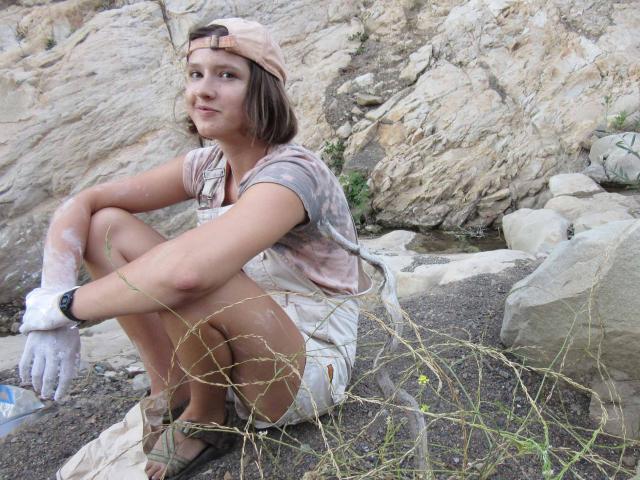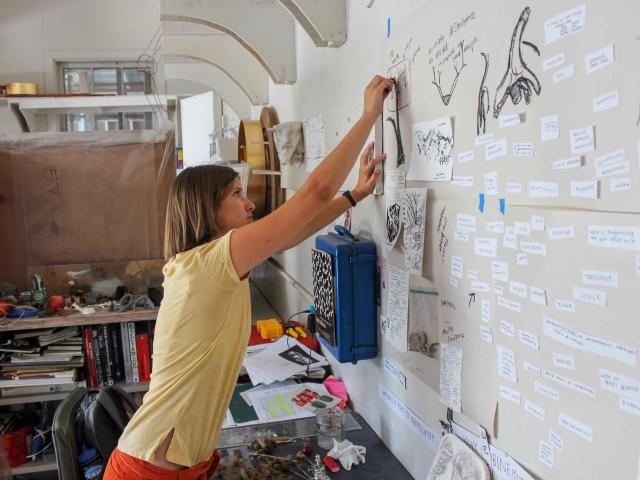Art from Ashes
CCS Artist and Biologist Sophie Nebeker uses research on Thomas Fire to inspire her art
By Will Proctor
For as long as she can remember, Sophie Nebeker, a third-year CCS Artist and Biologist, has used the surrounding world to inform her art. Supported by a donor-funded CCS Summer Undergraduate Fellowship, Nebeker spent much of the summer studying the effects of the Thomas Fire–the second largest fire California history–and subsequent severe debris flows with a UC Santa Barbara biology doctorate student. From this, she designed a sculpture to reflect the impact of these natural disasters.
The Thomas Fire provided a chance to see how an ecosystem is affected by a major disturbance. “I hesitate to call it an opportunity because it was a huge tragedy, but it was a fascinating way to see how an ecological community adapts to change,” she said. Working with Kate Culhane, a UC Santa Barbara Ph.D. student in Hilary Young’s lab, Nebeker studied how fire shapes a community ecosystem. By examining how the burning of the stream-side forest canopy led to increased algal growth, Nebeker and Culhane surveyed the influence on the associated community of invertebrates. “Kate will trace hydrogen isotopes from the insects' bodies samples up the food web to see how the diet of invertebrate communities changes based on the availability of aquatic algal or terrestrial leaf litter in the habitat,” Nebeker explained. “So when we were in the field, we would measure the stream hydrology and morphology and collect a lot of bugs.”

The entire time she was in the field, Nebeker tracked her sentiments to inform her art. Rather than create a real scene, such as an insect in a river, her piece focuses on impressions. “[My sculpture] is more like an abstract, kind of an emotional perspective,” she stated. “I've been distilling what feelings and words come to mind when I'm out there, and then make some form based off of those feelings.”
Nebeker’s unique position–as a Biologist and Artist–enabled her to create a work of art based on scientific research. And although it will be a piece of fine art, she approached her project with a science communications lens. “I find that a lot of my art is inspired by these natural shapes and forms, and the processes that create them,” said the Utah native. “I wanted to be able to make something visual, something you can approach that is beautiful while learning about the environment we live in.” Nebeker’s goal for the work was to convey complex information in an approachable and digestible way without sacrificing the integrity of the project. Nebeker continued: “You don't want to dumb things down or give false information, but you also don't want to overwhelm the viewer with detail, so it is an exciting line to walk.”
Nebeker feels more connected with sculpture than any other art form. “I really like sculpture because it utilizes an emotional component. Instead of looking at a painting, you are confronted physically with this object that you can walk around and interact with as well as have an intellectual relationship with." As she works mostly with metal and it is difficult to create organic shapes without heat, the artist worked with Emily Baker, a CCS Art faculty member, to create bronze castings.

Nebeker realizes that this project was a learning experience and is grateful that the CCS Summer Undergraduate Fellowship enabled her to explore her two disciplines. “This was an excellent learning experience to see how I can translate concepts into art,” she stated. “With this fellowship, I was able to explore whatever I wanted–my creative desires had no limit.” She continued: “I learned about these two seemingly disparate things, but this fellowship gave me the opportunity to work on one project, while still satisfying these two sides [science and art] of myself.”
2018 marked the first time the CCS Summer Undergraduate Fellowships, supported by The Create Fund launched during the College’s 50th Anniversary, were made available to all CCS students, including those majoring in Art, Writing and Literature, and Music Composition. Previously, the fellowships were focused solely on student summer research. Nebeker described how it felt to receive this funding. “It was a really amazing and liberating feeling because ... as an artist and a maker, you're not constantly having people say ‘let me help you, let me give you this so you can make art,’” she said.
Nebeker is one of 36 CCS students who received Summer Undergraduate Fellowships in 2018. CCS donors–alumni, parents, faculty, staff, and friends–completely funded each fellow, who spent up to 12 weeks working on a research or creative activity project. “It's awesome,” said Nebeker, “when individuals can support us and can give the necessary resources for these intellectual and creative projects.”
Nebeker will display her project at the 2018 CCS Research and Creative Activities Conference (RACA-CON) on November 3.